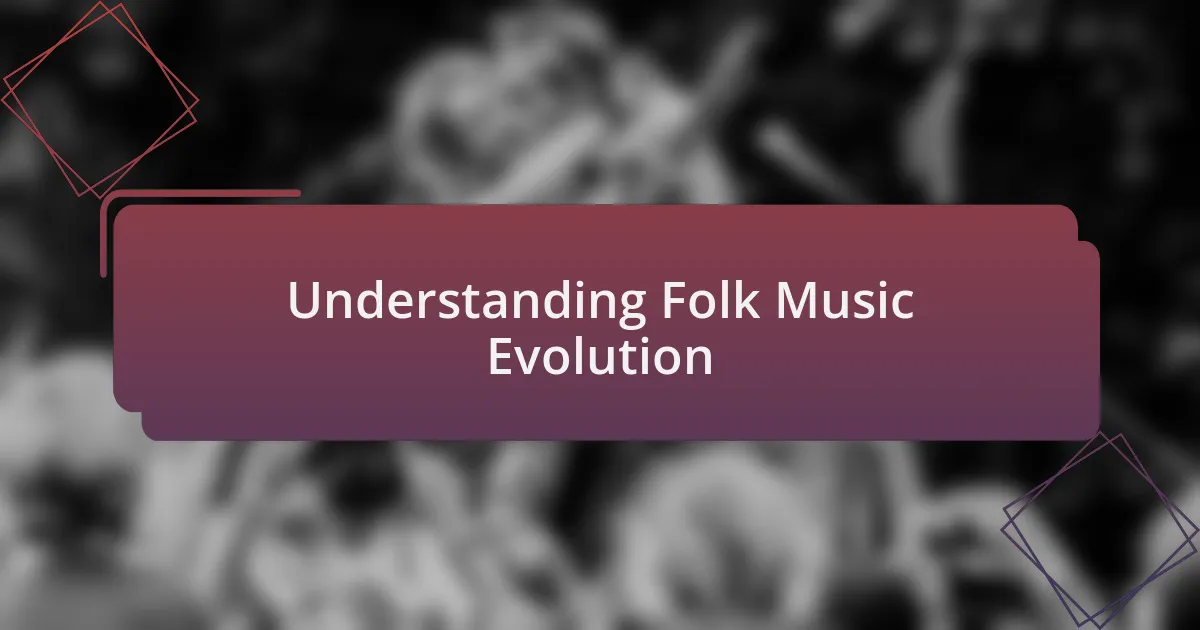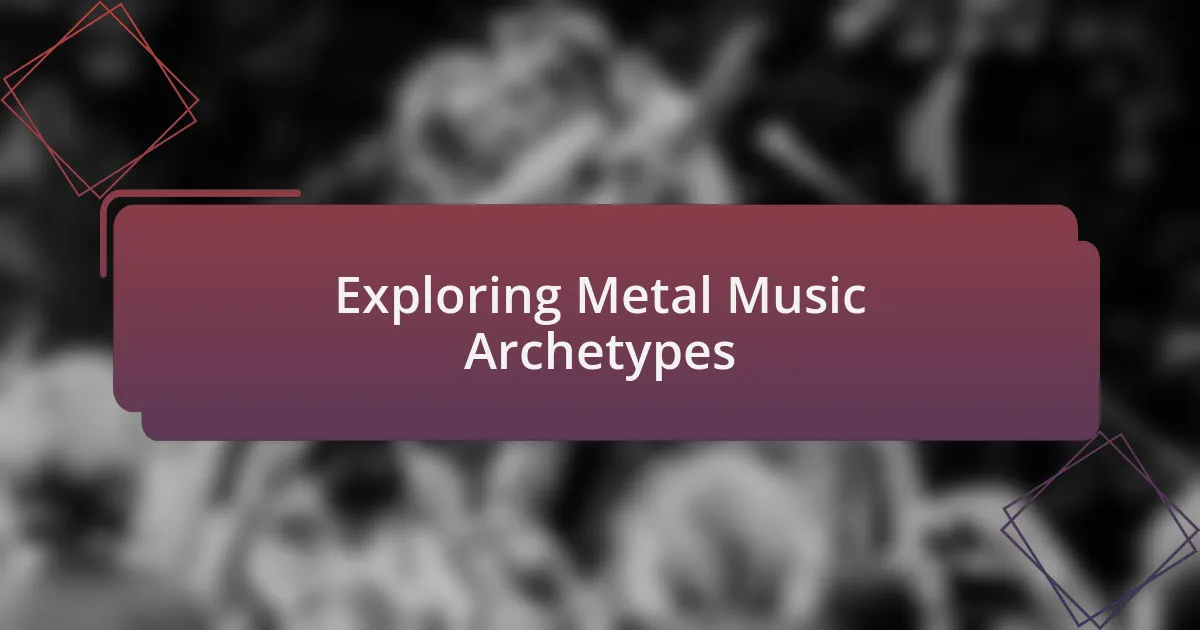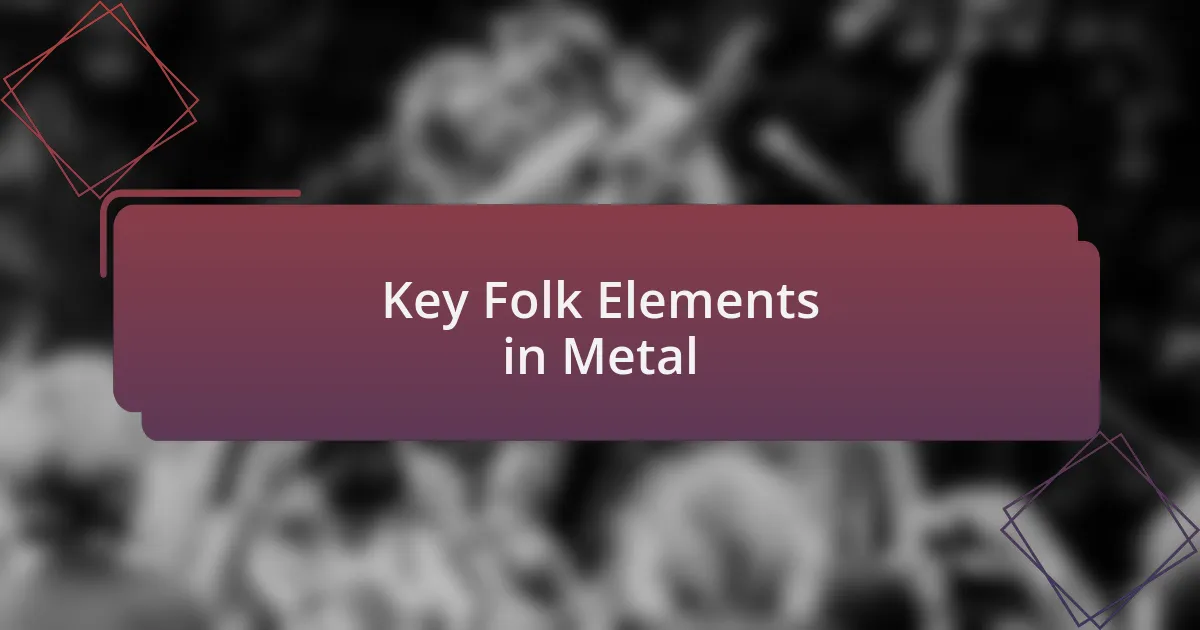Key takeaways:
- Folk music’s evolution reflects societal changes, often infusing modern genres like metal with authenticity and emotional depth.
- Common archetypes such as the hero’s journey and trickster themes connect folk traditions and metal, revealing shared emotional honesty and storytelling.
- The use of traditional instruments and communal themes in metal mirrors folk music’s narrative power, enhancing the experience of unity and shared struggles at concerts.
- Recommendations for folk metal bands include Eluveitie, Korpiklaani, and Finntroll, each contributing unique elements that bridge ancient folklore with modern expression.

Understanding Folk Music Evolution
Folk music has evolved remarkably over centuries, often reflecting the societal shifts and cultural narratives of the times. I find it fascinating how each region’s history, struggles, and joys are woven into their folk songs. Have you ever listened closely to the lyrics of a traditional ballad? It’s like unlocking a window to the past, revealing the emotions and stories that shaped a community.
As I dive deeper into folk music’s journey, I notice it often finds its way into modern genres, enriching them with a sense of authenticity. For example, many metal bands incorporate folk elements to ground their sound in something raw and relatable. It raises the question: how do these influences create a bridge between different musical worlds?
One poignant moment for me was hearing a metal band cover an old folk song with a heavy twist. That blend not only honored the original piece but also breathed new life into it, merging the cultural weight of folk tradition with metal’s intensity. The realization that music can evolve while still respecting its roots feels incredibly powerful, doesn’t it? Each note carries history, yet adapts to new realities, making folk music a living, breathing entity.

Exploring Metal Music Archetypes
When exploring metal music archetypes, I often notice how they mirror the fundamental archetypes found in folk traditions. Take, for instance, the hero’s journey—a prevalent theme in both genres. Listening to a power metal anthem, I can’t help but feel the surge of epic storytelling that resonates deeply, much like the tales sung by traveling bards who shared stories of valor and adventure.
Additionally, I’ve observed the shadow archetype playing a significant role in metal. The darker themes in many songs, reflecting struggles with identity and inner demons, remind me of the haunting melodies in traditional folk songs that speak of loss and hardship. There’s an emotional honesty in both forms; have you ever felt swept away by the raw power of a heavy guitar riff that conveys pain as effectively as any haunting folk lament? That connection is something I truly cherish.
Finally, the trickster archetype appears often in metal, reflecting a rebellious spirit similar to that found in folk music. Bands that incorporate humor or irony into their lyrics remind me of the folk tales where trickster figures challenge societal norms. I find myself laughing along, yet pondering deeper truths hidden beneath the surface. Isn’t it fascinating how these universal themes can transcend genres, creating a rich tapestry of connection through music?

Key Folk Elements in Metal
In my experience, one of the most captivating folk elements in metal is the use of traditional instruments, like the violin or flute. I vividly remember my first time hearing a folk metal band incorporate these sounds into their music; it felt like stepping into a vivid storybook. The way they intertwined these instruments with heavy guitar riffs created a unique blend that was both haunting and exhilarating. Don’t you think it’s incredible how a simple flute can transport you to ancient times while still feeling completely modern?
Another key aspect is storytelling, heavily influenced by folk traditions. Many metal songs narrate epic tales, much like folk ballads do. I recall being mesmerized by a band’s narrative about a legendary battle, where each lyric unfolded like a chapter in a gripping novel. It’s almost as if the singer leads us through a rich landscape of myth and fantasy. How powerful is it when music not only entertains but also immerses us in a complex narrative?
Lastly, I find the incorporation of communal themes in both genres particularly compelling. Folk music often gathers people together to share heartfelt experiences, and I’ve attended metal shows that evoke that same feeling of unity. There’s something electric about being in a crowd, where everyone is singing along to a song that speaks of shared struggles and triumphs. Have you ever felt that surge of collective energy at a concert? It’s a reminder that at its core, both folk and metal share a profound capacity to connect us through our shared human experiences.

Recommendations for Folk Metal Bands
When exploring the world of folk metal, I often find myself drawn to bands like Eluveitie. Their unique blend of traditional Celtic instruments with powerful metal guitar riffs captivated me the first time I heard their album “Slania.” I can still remember feeling an exhilarating rush as the melodies painted vivid landscapes of ancient folklore. Have you ever experienced that rush where music sweeps you away to another time and place?
Another recommendation I’d make is Korpiklaani, known for their vibrant energy and infectious rhythms. I recall seeing them live, and the way they engage the audience with foot-stomping tunes makes it impossible not to join in. Their songs often reflect themes around nature and community, showcasing a deep-rooted connection to traditions. Isn’t it amazing how their exuberance brings people together in joyous celebration?
Lastly, I can’t overlook Finntroll, who blend elements of folk metal with an unmistakable sense of humor and a darker edge. Their music never fails to transport me to a fantastical realm where trolls roam, and epic battles await. The playful yet heavy sound is something that lingers in my mind long after the last note fades. Do you think music should always be serious, or is there room for playful mischief in the metal scene?